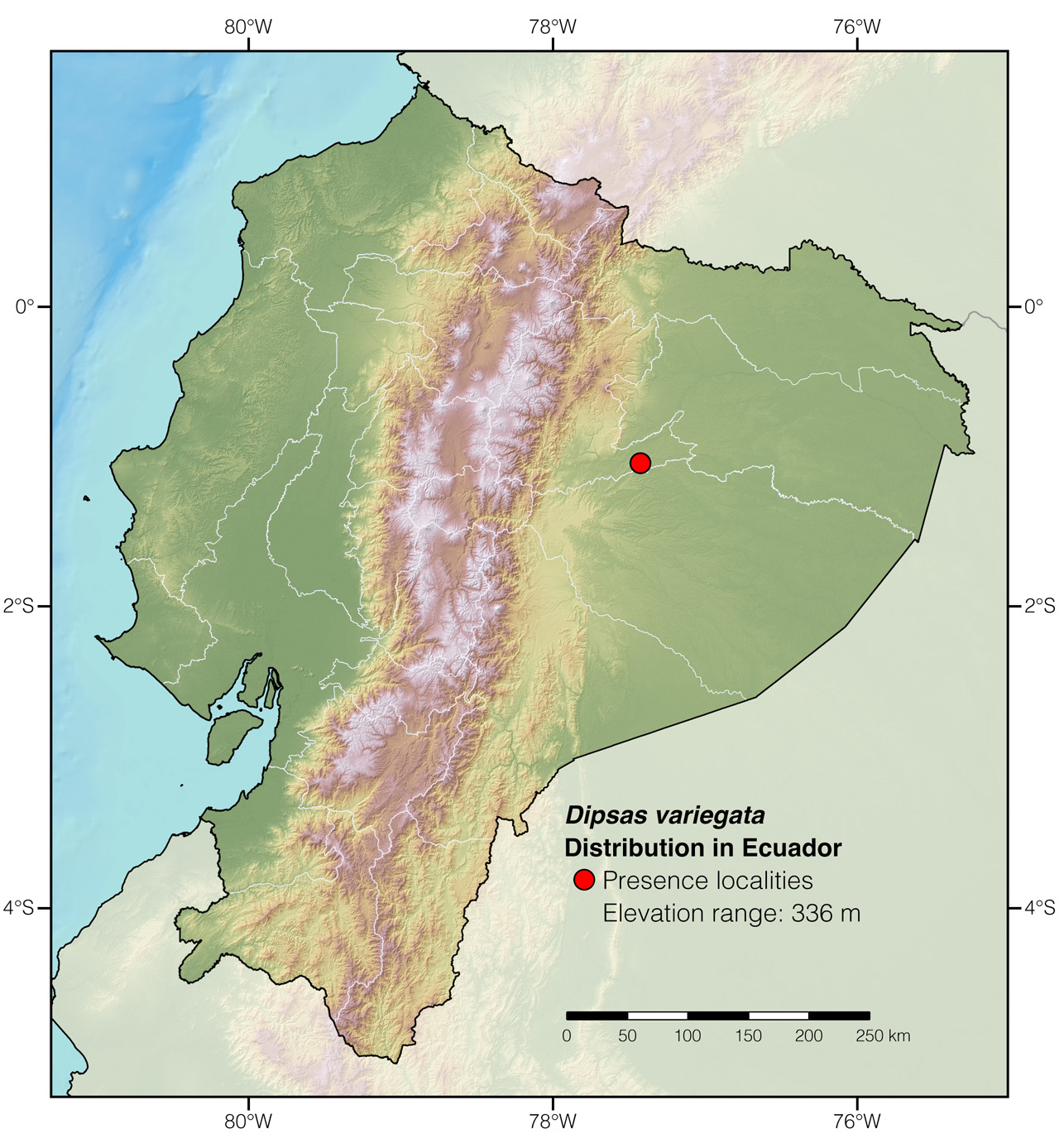Published May 12, 2018. Updated April 12, 2024. Open access. | Purchase book ❯ |
Variegated Snail-eating Snake (Dipsas variegata)
Reptiles of Ecuador | Serpentes | Colubridae | Dipsas variegata
English common name: Variegated Snail-eating Snake.
Spanish common name: Caracolera jaspeada.
Recognition: ♂♂ 91.2 cmMaximum distance from the snout to the tip of the tail. Snout–vent length=69.3 cm. ♀♀ 86.9 cmMaximum distance from the snout to the tip of the tail. Snout–vent length=67.4 cm..1 Dipsas variegata can be identified by having a grayish dorsum with 26–48 elliptical blackish blotches and a blunt, prominent head with black markings that lack yellow borders (Fig. 1).1–4 This species differs from D. indica by lacking yellow reticulations on the dorsal aspect of the head. Additionally, the body blotches in D. indica are triangular, instead of elliptical, and widest at the ventrals.4

Figure 1: Adult female of Dipsas variegata from Gareno, Napo province, Ecuador.
Natural history: Dipsas variegata is a nocturnal snake that, in Ecuador, has only been found in old-growth rainforest,2 but elsewhere it also occurs in seasonally dry forests.3–6 Variegated Snail-Eaters are active at night, especially if it is raining or drizzling. Their movements are slow, graceful, and generally occur during the first hours of the night at ground level or on vegetation within 3 m from the ground.1–7 During the day, they remain hidden under surface debris or coiled up on branches of woody plants and tree ferns 1.5–3 m above the ground.1–7 The diet in this species consists of slugs and snails,5–7 which are presumably immobilized by the use of toxins secreted by the mucous cells of the infralabial glands.8 Nevertheless, all snakes in the genus Dipsas are considered harmless to humans. They never attempt to bite, resorting instead to coiling into a defensive posture and producing a musky and distasteful odor when threatened.9 A gravid female from Venezuela contained five eggs,5 which probably corresponds to the actual clutch size. It is hypothesized that this species mimics vipers of the genus Bothrops.5
Conservation: Least Concern Believed to be safe from extinction given current circumstances..10 Dipsas variegata is listed in this category because the species is widely distributed, frequently encountered in the northern part of its range, occurs in protected areas, and is considered to be facing no major immediate extinction threats.10
Distribution: Dipsas variegata occurs as four disjunctive populations. One in the Amazonian lowlands of Bolivia, Brazil, Ecuador (Fig. 2), and Peru. A second one in the Guiana Shield in Brazil, Guyana, French Guiana, Suriname, and Venezuela. A third one in Trinidad and Tobago and the coastal cordilleras and Andean foothills of Venezuela. The fourth one occurs in the Atlantic Forest of Brazil.

Figure 2: Distribution of Dipsas variegata in Ecuador. The single dot corresponds to Gareno, Napo province.
Etymology: The name Dipsas comes from the Greek dipsa (=thirst)11 and probably refers to the fact that the bite of these snakes was believed to cause intense thirst. The specific epithet variegata is a Latin word meaning “of various colors.”11
See it in the wild: In Ecuador, the Variegated Snail-eating Snake cannot be expected to be seen reliably as there is only one record of the species in the country.
Author: Alejandro ArteagaaAffiliation: Fundación Khamai, Reserva Arlequín, Ecoruta Paseo del Quinde km 56, Santa Rosa de Mindo, Pichincha 171202, Ecuador.
Photographer: Jose VieirabAffiliation: Tropical Herping (TH), Quito, Ecuador.,cAffiliation: ExSitu, Quito, Ecuador.
How to cite? Arteaga A (2024) Variegated Snail-eating Snake (Dipsas variegata). In: Arteaga A, Bustamante L, Vieira J (Eds) Reptiles of Ecuador: Life in the middle of the world. Available from: www.reptilesofecuador.com. DOI: 10.47051/KTCV8572
Literature cited:
- Harvey MB, Embert D (2008) Review of Bolivian Dipsas (Serpentes: Colubridae), with comments on other south American species. Herpetological Monographs 22: 54–105. DOI: 10.1655/07-023.1
- Arteaga A, Salazar-Valenzuela D, Mebert K, Peñafiel N, Aguiar G, Sánchez-Nivicela JC, Pyron RA, Colston TJ, Cisneros-Heredia DF, Yánez-Muñoz MH, Venegas PJ, Guayasamin JM, Torres-Carvajal O (2018) Systematics of South American snail-eating snakes (Serpentes, Dipsadini), with the description of five new species from Ecuador and Peru. ZooKeys 766: 79–147. DOI: 10.3897/zookeys.766.24523
- Murphy JC, Downie R, Smith JM, Livingstone S, Mohammed R, Lehtinen RM, Eyre M, Sewlal JN, Noriega N, Casper GS, Anton T, Rutherford MG, Braswell AL, Jowers MJ (2018) A field guide to the amphibians & reptiles of Trinidad and Tobago. Trinidad and Tobago Naturalist’s Club, Port of Spain, 336 pp.
- Peters JA (1960) The snakes of the subfamily Dipsadinae. Miscellaneous Publications, Museum of Zoology, Univesity of Michigan 114: 1–224.
- Natera-Mumaw M, Esqueda-González LF, Castelaín-Fernández M (2015) Atlas serpientes de Venezuela. Dimacofi Negocios Avanzados S.A., Santiago de Chile, 456 pp.
- Lotzkat S, Natera-Mumaw M, Hertz A, Sunyer J, Mora D (2008) New state records of Dipsas variegata (Duméril, Bibron and Duméril 1854) (Serpentes: Colubridae) from northern Venezuela, with comments on natural history. Herpetotropicos 4: 25–29.
- Duellman WE (2005) Cusco amazónico: the lives of amphibians and reptiles in an Amazonian rainforest. Cornell University Press, Ithaca, 433 pp.
- De Oliveira L, Jared C, da Costa Prudente AL, Zaher H, Antoniazzi MM (2008) Oral glands in dipsadine “goo-eater” snakes: morphology and histochemistry of the infralabial glands in Atractus reticulatus, Dipsas indica, and Sibynomorphus mikanii. Toxicon 51: 898–913. DOI: 10.1016/j.toxicon.2007.12.021
- Cadle JE, Myers CW (2003) Systematics of snakes referred to Dipsas variegata in Panama and Western South America, with revalidation of two species and notes on defensive behaviors in the Dipsadini (Colubridae). American Museum Novitates 3409: 1–47.
- Catenazzi A, Gonzales L, Hoogmoed M, Nogueira C, Cisneros-Heredia DF, Schargel W, Rivas G, Murphy J (2019) Dipsas variegata. The IUCN Red List of threatened species. Available from: www.iucnredlist.org. DOI: 10.2305/IUCN.UK.2019-3.RLTS.T50951426A50951434.en
- Brown RW (1956) Composition of scientific words. Smithsonian Books, Washington D.C., 882 pp.